Although the hedge-cutting ban doesn’t lift until 1 September, maintenance is still something that can be considered or undertaken on a wet day over the summer period, in order to avoid that last-minute rush before the season kicks off.
Below, we look at some of the key areas worth considering when it comes to service and setting up a hedge cutter, in order to get the best performance.
Given the nature of these machines, with numerous pivot points and forces being exerted, not only is regular maintenance important to prevent wear and costly repair bills, but a routine inspection is also important. Skimping on maintenance may seem like a time-saving solution, but more often than not, it catches up and costs a pretty penny in repair bills. If this is a task you feel unsure about, then consider having your local dealer do it for you.

All pins and bushes need to be frequently greased.
1. Storage
Storage is a good starting point and tends to be the best preventative maintenance solution for all machinery. Dry storage during the closed season has many benefits, including the avoidance of water ingress to electrical components as well as pins and bushings and bearings, rusting of paint work and chrome on hydraulic rams. Over long periods of exposure to daylight, the paint work can suffer and fade, degrading the overall appearance of the machine.
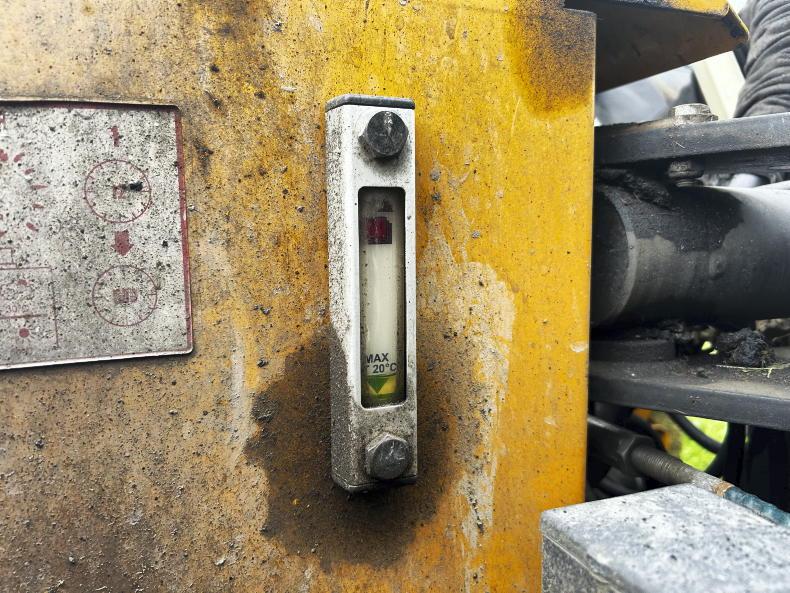
Hydraulic oil level should be checked frequently and replaced every 500 hours.
2. Gearbox and hydraulic pump
Gearboxes should be given the once over, looking out for leaks, before then assessing oil levels. A milky oil colour indicates water ingress. It is recommended that oil is changed after the first 50 hours and every 250 hours thereafter. Depending on age and model, the more common oils are 75/90 fully synthetic, or 80/90 mineral oil. Gearboxes, once maintained correctly, are trouble-free components and should run for thousands of hours.
If the gearbox has proved noisy for a period and its oil looks a dirty grey colour, the chances are that a bearing has failed. If caught in time, bearings can be replaced. Worst-case scenario is that damage may also have been done to the hydraulic pump.
A similar approach should be taken for the hydraulic oil tank, checking both oil level and its condition. The majority of machines today use hydraulic oil 46. The hydraulic oil filter should be changed every 500 hours, or more frequently if needs be.
Where possible, prevent overheating of the hydraulic oil. This commonly happens where a 540rpm gearbox is operated in a 1,000rpm and over revved making manoeuvres. Overheating can damage O-rings and seals, causing further damage and premature component failure.

An unbalanced rotor is not only uncomfortable to use, but it will cause further damage to the head.
3. Hydraulic hoses and oil cooler
It is inevitable that a hose will get damaged at some point, become perished and burst, or be at high risk of bursting. It is crucial that replacement hoses are rated to the correct pressure to prevent premature failure. Opt for the highest pressure rating possible. On a 65hp machine, opt for no less than hoses rated to 3,200psi, and 4,400psi on 85hp machines.
Where fitted, the oil cooler should be regularly checked, ensuring it is working and that the electric fan is engaging and disengaging. The small radiator may need to be cleaned out frequently, depending on your work environment.
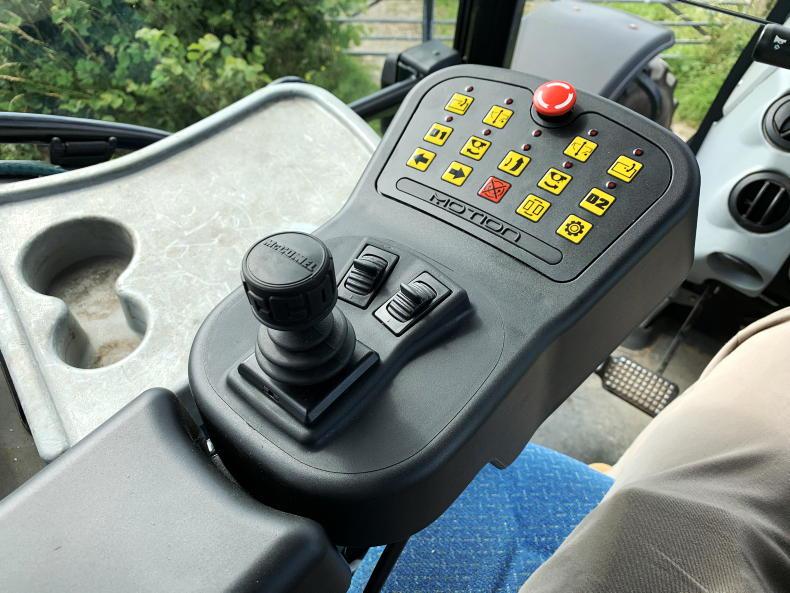
Once kept dry, controls tend to be trouble free.
4. Arms, pins and bushes
If a machine is respected and not abused or neglected, then the booms should never need to be touched. That said, cracks and strain can occur, so pay attention and have any issue repaired ASAP. Pay attention to the way in which the arm sits on its transport rest, a bent arm generally doesn’t sit centrally. Many telescopic machines with variable forward reach will require further maintenance. Most will have nylon wear plates to keep wear to a minimum. Every so often the arm should be fully extended and checked over. If required by the manufacturer, this area should be regularly greased. All bushes are subject to strain, so daily greasing with a premium pin and bush grease is advised. Even with daily greasing, pins and bushes will still come to a point where replacement is necessary. Pay close attention to wear and, if possible, replace bushes before pins need replacing. Remember, cartridges of grease costing €5 will prove cheap compared with having to prematurely replace pins and bushes.
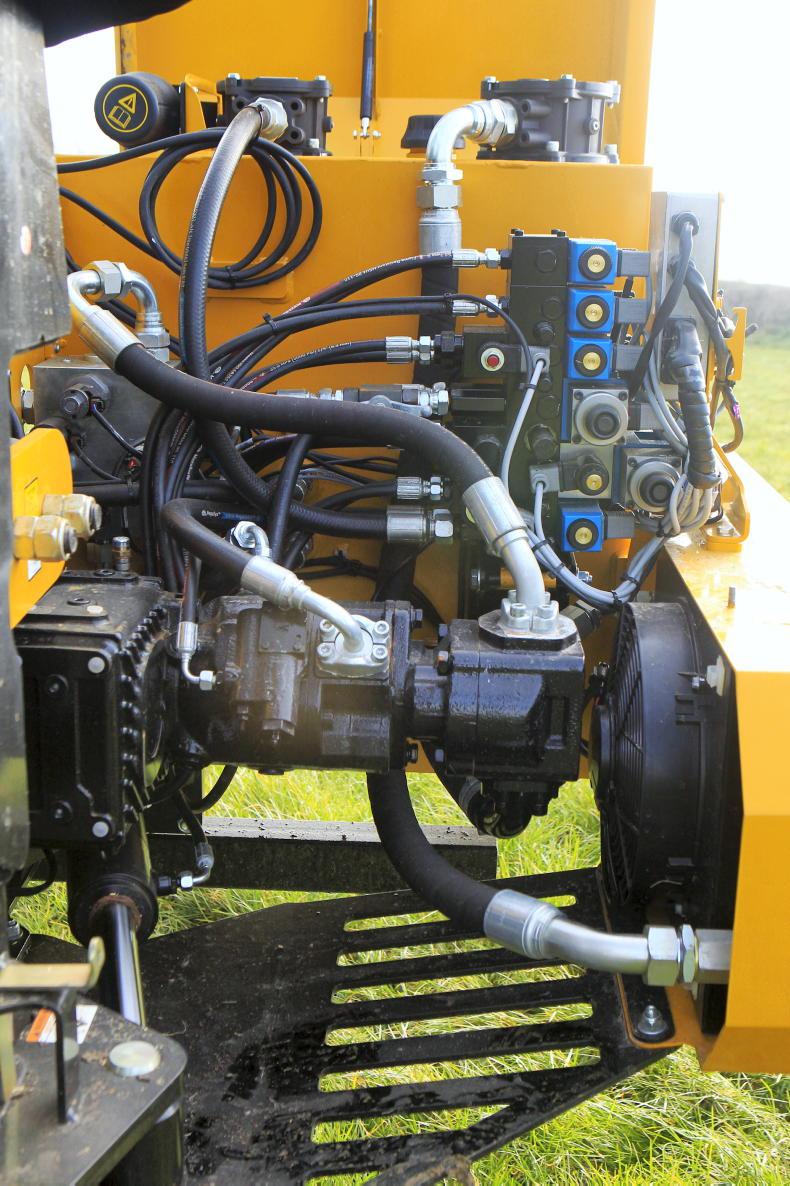
The hydraulic oil should be replaced every 500 hours to prolong the lifespan of the pump.
5. Cutting head
Naturally, the cutting head is subject to the majority of the abuse. Given the high rotational speeds of the rotor (up to 3,000rpm), balance is key for longevity and operator comfort. However, over time rotors will lose their balance from wear and tear and colliding with foreign objects. An unbalanced rotor will eventually vibrate every nut and bolt loose on the head, leading to further problems.
The proper solution is to have it removed professionally. This process involves the fitment of new flails and bushes.
To prevent rotor wear, all flail bolts should be tight, otherwise the holes in the rotor lugs will become elongated over time. Rotor bearings will need a shot of grease a number of times throughout the day, unwanted movement in the rotor when stationary and or the smell of burnt grease are good indicators that bearings are in need of replacement. Flaps at the front of the head minimise the degree of debris that can fly out. Damaged or missing flaps need to be replaced. Heavier duty versions are available.
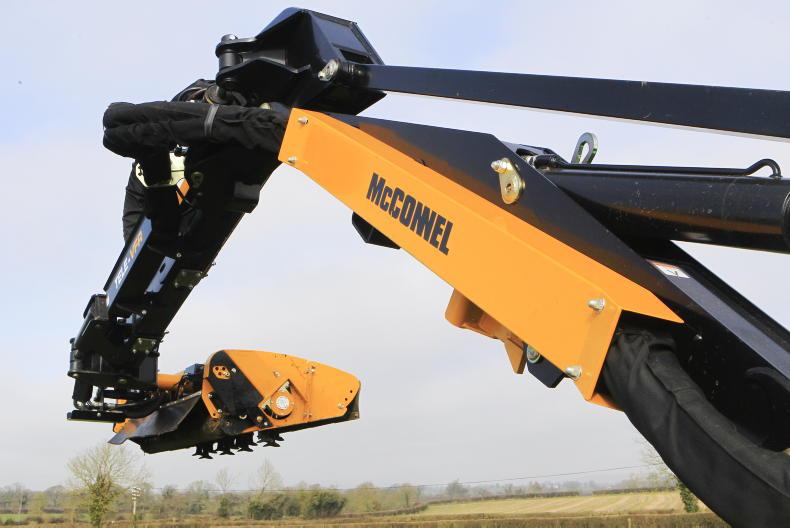
All arms, including those which are telescopic, should be inspected for damage and wear.
6. Controls
As outlined at the start, the lifespan of modern electronic controls is enhanced with dry storage. When electrical connections or contacts get wet, corrosion occurs. Depending on its location and severity, it may be fixable. But, corrosion on circuit board and similar internal components tends to result in a costly replacement. Electronic issues can be intermittent, with the possibility of letting an operator down at any time.
Although less common today, cable controls are still simple, practical and effective. From a maintenance aspect, it’s important to check that each lever and cable is moving freely. Penetrating oil may be enough to free up a stiffened cable, or replacement is an option.
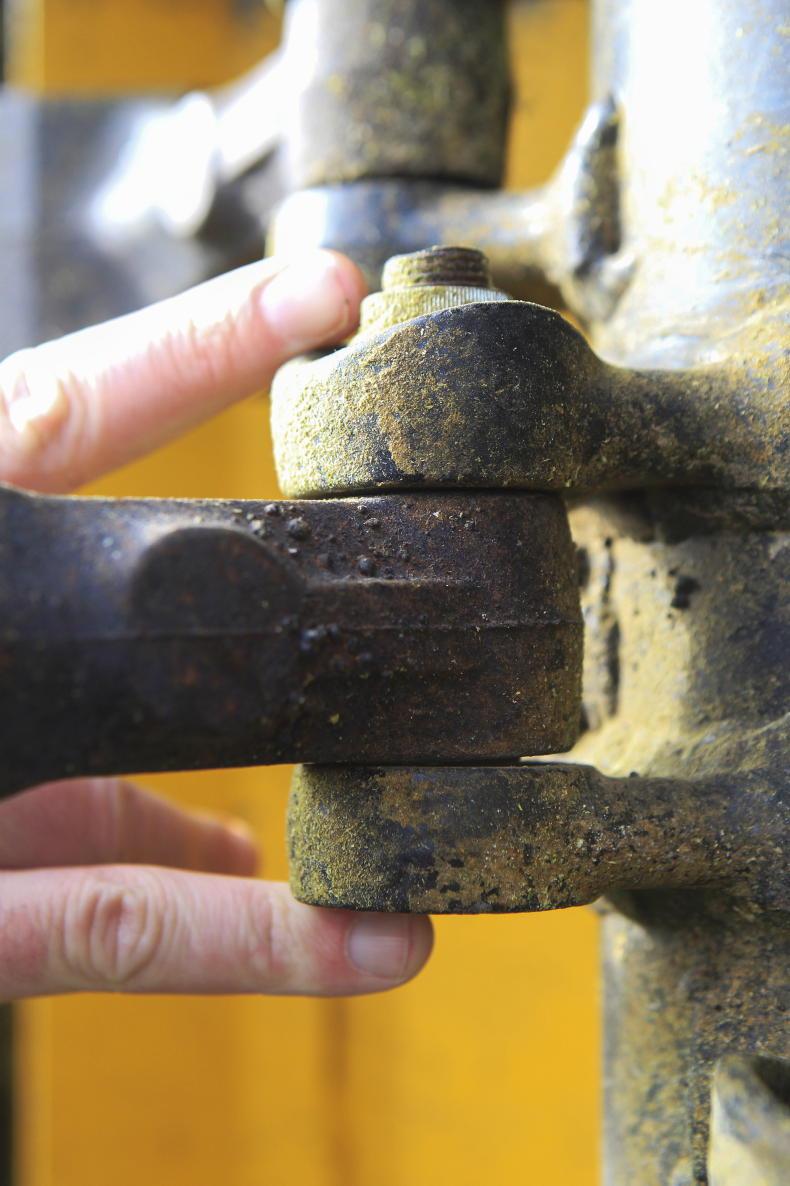
Flail bolts should be tight to prevent hanger wear.
7. Buying a used machine
Many of the points discussed stand true when scouting the market for a used machine. Popular machines, such as those offering 6.5m reach and a 65hp hydraulic motor, tend to be the more costly second-hand seller. Larger machines can often be bought cheaper. A machine that has been cosmetically well maintained is likely to have been mechanically well maintained too. Machines with issues or parts in need of repair should be inspected in detail and the cost of replacement parts also weighed up.

F10 T-shaped flails are the most common flail type used.

All replacement hydraulic pipes should have the correct pressure rating.

The rotor bearings and roller bearings should receive grease a number of time daily during use.
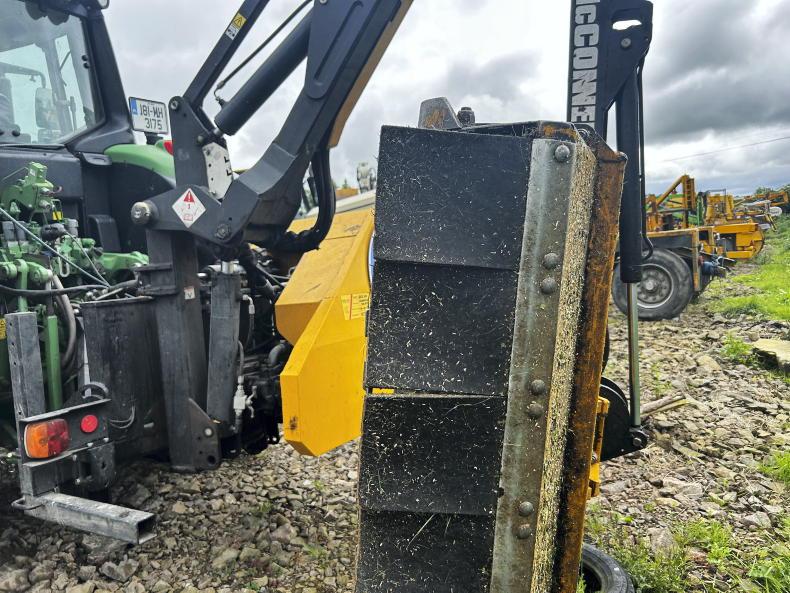
All rubber flaps should be present at the front of the hood.
Although the hedge-cutting ban doesn’t lift until 1 September, maintenance is still something that can be considered or undertaken on a wet day over the summer period, in order to avoid that last-minute rush before the season kicks off.
Below, we look at some of the key areas worth considering when it comes to service and setting up a hedge cutter, in order to get the best performance.
Given the nature of these machines, with numerous pivot points and forces being exerted, not only is regular maintenance important to prevent wear and costly repair bills, but a routine inspection is also important. Skimping on maintenance may seem like a time-saving solution, but more often than not, it catches up and costs a pretty penny in repair bills. If this is a task you feel unsure about, then consider having your local dealer do it for you.

All pins and bushes need to be frequently greased.
1. Storage
Storage is a good starting point and tends to be the best preventative maintenance solution for all machinery. Dry storage during the closed season has many benefits, including the avoidance of water ingress to electrical components as well as pins and bushings and bearings, rusting of paint work and chrome on hydraulic rams. Over long periods of exposure to daylight, the paint work can suffer and fade, degrading the overall appearance of the machine.

Hydraulic oil level should be checked frequently and replaced every 500 hours.
2. Gearbox and hydraulic pump
Gearboxes should be given the once over, looking out for leaks, before then assessing oil levels. A milky oil colour indicates water ingress. It is recommended that oil is changed after the first 50 hours and every 250 hours thereafter. Depending on age and model, the more common oils are 75/90 fully synthetic, or 80/90 mineral oil. Gearboxes, once maintained correctly, are trouble-free components and should run for thousands of hours.
If the gearbox has proved noisy for a period and its oil looks a dirty grey colour, the chances are that a bearing has failed. If caught in time, bearings can be replaced. Worst-case scenario is that damage may also have been done to the hydraulic pump.
A similar approach should be taken for the hydraulic oil tank, checking both oil level and its condition. The majority of machines today use hydraulic oil 46. The hydraulic oil filter should be changed every 500 hours, or more frequently if needs be.
Where possible, prevent overheating of the hydraulic oil. This commonly happens where a 540rpm gearbox is operated in a 1,000rpm and over revved making manoeuvres. Overheating can damage O-rings and seals, causing further damage and premature component failure.

An unbalanced rotor is not only uncomfortable to use, but it will cause further damage to the head.
3. Hydraulic hoses and oil cooler
It is inevitable that a hose will get damaged at some point, become perished and burst, or be at high risk of bursting. It is crucial that replacement hoses are rated to the correct pressure to prevent premature failure. Opt for the highest pressure rating possible. On a 65hp machine, opt for no less than hoses rated to 3,200psi, and 4,400psi on 85hp machines.
Where fitted, the oil cooler should be regularly checked, ensuring it is working and that the electric fan is engaging and disengaging. The small radiator may need to be cleaned out frequently, depending on your work environment.

Once kept dry, controls tend to be trouble free.
4. Arms, pins and bushes
If a machine is respected and not abused or neglected, then the booms should never need to be touched. That said, cracks and strain can occur, so pay attention and have any issue repaired ASAP. Pay attention to the way in which the arm sits on its transport rest, a bent arm generally doesn’t sit centrally. Many telescopic machines with variable forward reach will require further maintenance. Most will have nylon wear plates to keep wear to a minimum. Every so often the arm should be fully extended and checked over. If required by the manufacturer, this area should be regularly greased. All bushes are subject to strain, so daily greasing with a premium pin and bush grease is advised. Even with daily greasing, pins and bushes will still come to a point where replacement is necessary. Pay close attention to wear and, if possible, replace bushes before pins need replacing. Remember, cartridges of grease costing €5 will prove cheap compared with having to prematurely replace pins and bushes.

The hydraulic oil should be replaced every 500 hours to prolong the lifespan of the pump.
5. Cutting head
Naturally, the cutting head is subject to the majority of the abuse. Given the high rotational speeds of the rotor (up to 3,000rpm), balance is key for longevity and operator comfort. However, over time rotors will lose their balance from wear and tear and colliding with foreign objects. An unbalanced rotor will eventually vibrate every nut and bolt loose on the head, leading to further problems.
The proper solution is to have it removed professionally. This process involves the fitment of new flails and bushes.
To prevent rotor wear, all flail bolts should be tight, otherwise the holes in the rotor lugs will become elongated over time. Rotor bearings will need a shot of grease a number of times throughout the day, unwanted movement in the rotor when stationary and or the smell of burnt grease are good indicators that bearings are in need of replacement. Flaps at the front of the head minimise the degree of debris that can fly out. Damaged or missing flaps need to be replaced. Heavier duty versions are available.

All arms, including those which are telescopic, should be inspected for damage and wear.
6. Controls
As outlined at the start, the lifespan of modern electronic controls is enhanced with dry storage. When electrical connections or contacts get wet, corrosion occurs. Depending on its location and severity, it may be fixable. But, corrosion on circuit board and similar internal components tends to result in a costly replacement. Electronic issues can be intermittent, with the possibility of letting an operator down at any time.
Although less common today, cable controls are still simple, practical and effective. From a maintenance aspect, it’s important to check that each lever and cable is moving freely. Penetrating oil may be enough to free up a stiffened cable, or replacement is an option.

Flail bolts should be tight to prevent hanger wear.
7. Buying a used machine
Many of the points discussed stand true when scouting the market for a used machine. Popular machines, such as those offering 6.5m reach and a 65hp hydraulic motor, tend to be the more costly second-hand seller. Larger machines can often be bought cheaper. A machine that has been cosmetically well maintained is likely to have been mechanically well maintained too. Machines with issues or parts in need of repair should be inspected in detail and the cost of replacement parts also weighed up.

F10 T-shaped flails are the most common flail type used.

All replacement hydraulic pipes should have the correct pressure rating.

The rotor bearings and roller bearings should receive grease a number of time daily during use.

All rubber flaps should be present at the front of the hood.

















 This is a subscriber-only article
This is a subscriber-only article









SHARING OPTIONS: